East Jurain: Worst place to live in Dhaka?
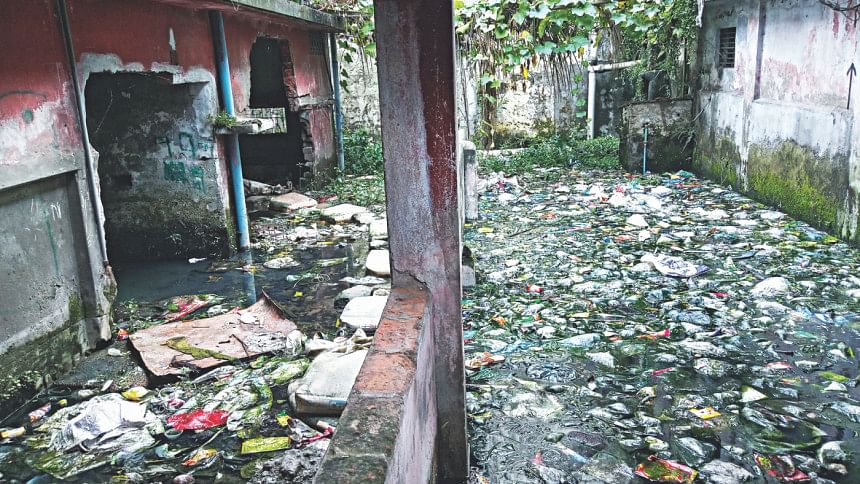
Ashraful Islam, a retired government official, built a two-story house in Dhaka's east Jurain neighbourhood in 1996. He spent his forty years of savings and even exhausted his wife's fixed deposit to build this dwelling. After completing all the tasks, he and his wife named it "Niribili" (tranquil). "My only hope was that I could secure a shelter for my wife and children in Dhaka," says Ashraf. "I gathered all my assets and invested everything to build the house. With my hard-earned money, I could only afford to purchase a plot in east Jurain. It never looked healthy—I never liked the narrow lanes and the convoluted network of uncovered sewerage lines all over the place. However, I liked its remoteness from the hubbub of the city. With three of my children, I and my wife spent some of the best years of my life in my home."
His family's peaceful days were numbered. "In 1998, most parts of Jurain were flooded but the lane adjacent to my home was spared thanks to the local people's initiative of sandbagging the nearby Kutubkhali canal. However, later that year, we noticed that the flood water was not receding. Instead, the water level inside the neighbourhood was rising due to intermittent rainfall throughout the year. We removed the sandbags from the canals to drain away the clogged water but to no avail. Gradually, the rising water engulfed the entire neighbourhood."
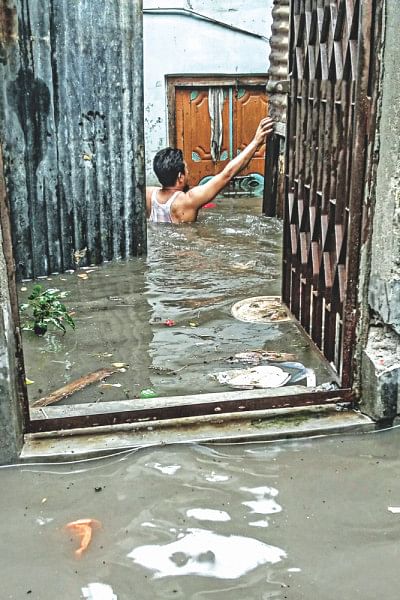
The situation worsened when all the waste from the overflowing sewerage lines got mixed with the clogged water which started to flood the ground floor of many buildings of east Jurain. As a result, many inhabitants like Ashraf had to leave the neighbourhood forever. "My precious plot of land which I bought with all my savings is now submerged under filthy water. Niribili lies abandoned and decaying. At 73, I and my ageing wife are living in a congested, rented apartment in Khilgaon," says Ashraf.
Ashraful is only one of many east Jurain inhabitants who lost all their belongings to permanent water logging. Jurain has been battling persistent flooding for more than 20 years, but no effective measure has been taken to solve this crisis which has now turned into a catastrophe. In some parts of the locality, local people covered the roads with dirt and sand to increase their height so as to keep it free from water logging. Dhaka South City Corporation (DSCC) has also been implementing a costly project of Tk 28 crore to increase the height of all the major roads in east Jurain. In some parts, they have been implementing this project for more than a decade. It has submitted another project of taka 10 crore to increase the height of all the lanes. According to DSCC officials, the first phase of road restoration will be finished by December this year. However, instead of solving the water-logging crisis, DSCC's road restoration project has deteriorated the situation.
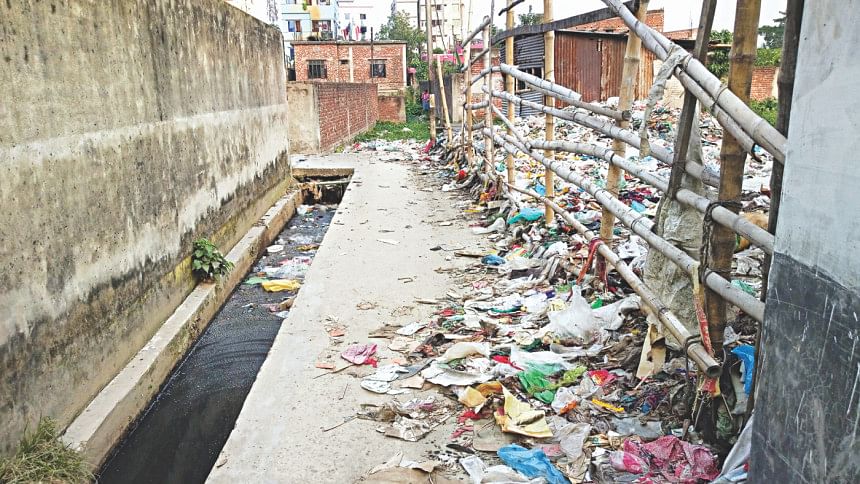
Some lanes such as Commissioner Road, Shobujbag, Nurani Masjid road, and Haji Kala Mian Sardar road have been heightened up to six to 10 feet. As a result, the ground floors of most buildings along these roads are fully or half-buried. Most of the first and second storey windows are barely adjacent to the restored roads. As the gates to the staircases became buried and unusable, their dwellers had to pull down some parts of the walls to create doorways, making these structures extremely weak and unsafe.
A large number of abandoned and half buried buildings gives a desolate and haunted look to this area despite it being one of the most over-populated parts of Dhaka city. Anyone unfamiliar with the crisis might think that the entire zone was badly affected by an earthquake and subsequent flood. Inhabitants of many of these buildings were forced to leave their homes and shop and factory owners had to close their establishments. The water logging situation remains the same and, due to the increased height of the roads, run-off water from the lanes now also leaks into the buildings.
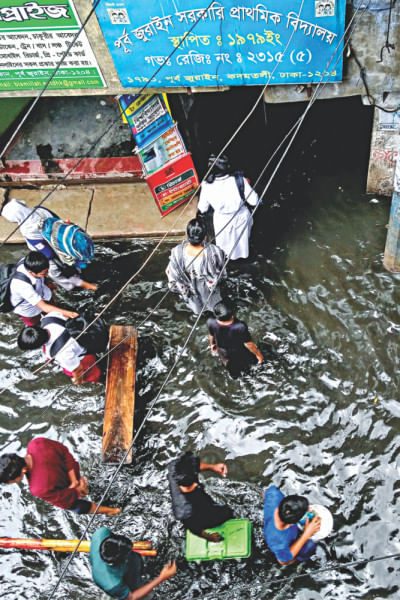
Araj Ali Sarder, a local inhabitant who owns a grocery shop and an apartment on Commissioner Road says, "I had to close my shop due to this road restoration project. We, the local people here, had hoped that the DSCC would drain out the clogged water and we would be able to live and run our businesses in peace. Instead of taking out the water, they are just making us jobless and homeless. I have had to demolish my shop twice to keep it on the same level as the road. But the problem is they don't restore the road entirely in one go. This year, they perhaps increased the height of the road to four feet. Next year, they might come again to raise it up to five feet to cope with the increasing water level. In this way, our locality is becoming increasingly unliveable and we have become victims to the whimsies of the government officials."
The never-ending road construction and maintenance has also caused other hazards. Due to the constant digging, the existing sewerage system has been completely destroyed and has never been repaired. During holidays, when many people stay at home and use water for household chores, many lanes of the lanes in east Jurain become even more flooded. Thousands of people have to live with floating human waste and filth all around their houses.
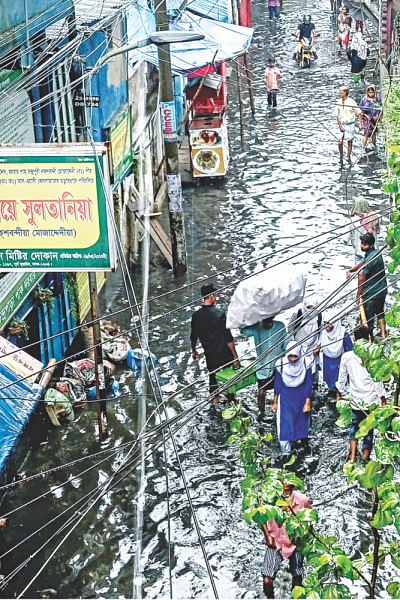
Road construction has also caused severe dust pollution in the area. "In addition to typhoid, diarrhoea, and skin diseases, our children are suffering from constant coughing due to intolerable dust pollution. On dry, hot days we cannot go outside without a mask. We cannot see objects even a few yards away due to a thick layer of dust in the air. Nobody actually cares about our sufferings," says Araj. Leakage in gas pipelines is also a frequent incident in Jurain. Subterrenean gas pipelines are so leaked and damaged by the road restoration project that very few homes can use their gas connections. Residents live with the risk of fatal accidents that can happen any time.
DSCC, however, denies these allegations. Mithun Chandra Shil, executive engineer, zone-5 of DSCC says, "We are restoring the roads due to frequent requests from the local inhabitants. As they realised that they had no other alternative to increasing the height of the roads, we have taken up this project upon their request. In our survey, we found that there are some higher roads in Jurain which do not get flooded during monsoon. We are trying to raise the height of all the lanes up to that level. We shall be able to complete restoration of the main lanes by December this year. We are expecting to start restoring the other lanes soon, which will significantly solve the problem."
Nevertheless, DSCC's strategy to solve the crisis is not liked by many as it does not address the root cause of the problem. Mijanur Rahman, a renowned social worker who hit the headlines several times for his bold and innovative demonstrations highlighting the crises in east Jurain, was born and brought up in this neighbourhood. He focuses on the history of this locality which helps identify the origin of the crisis. In the 1960s, most parts of Jurain were low-lying floodplains where local farmers could grow poor quality rice only once a year. "Even in the late 1970s there were large tracts of rice fields in this area. The farmers here could not grow good quality rice because this area is shaped like a sink. All the surrounding areas like Dolairpar, Jurain rail-gate, and Dania are almost 10 feet higher than east Jurain. Therefore, rainwater used to flow down to this area and during monsoon, it would be heavily inundated, making it unsuitable for cultivation," says Mijan.
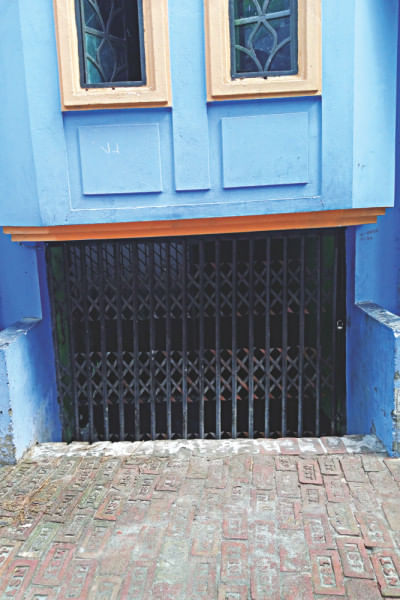
In 1965, the then Pakistan government started the Dhaka-Narayanganj-Demra (DND) embankment project to improve irrigation and to protect Dhaka from flooding. The croplands used to be irrigated with a network of canals such as Titas, Kutubkhali, Shobujbag, Shyampur etc. These canals also carried excess water to the Buriganga river and prevented waterlogging in the neighbourhood. According to Mijan, in the late 1970s, people from different parts of the country started to purchase croplands and erect houses indiscriminately. There was no sewerage system and waste management system, and no proper road networks, in Jurain even in the early 1990s. In the absence of any town planning, the entire east Jurain area became one of the most densely populated residential areas of the city. As a result, the network of canals which used to work as a drainage system for the entire area was filled up to make way for residential housing; many of them were even simply blocked by piles of solid waste. At present, many of these canals are completely lost due to encroachment, and most parts of Titas and Kutubkhali canals are blocked by huge amounts of waste.
"I and many inhabitants of east Jurain think that the restoration of these canals, maintenance of dilapidated sewerage system, and development of a waste management system are the only feasible solutions to the present crisis. Repairing roads and increasing their heights will only deteriorate the situation," says Mijan. Mijan's concern is shared by the engineers of Bangladesh Water Development Board (BWDB), who have also been working to prevent waterlogging in the area. Abdul Matin, superintendent engineer of BWDB says, "Since the entire east Jurain is like a large basin, vertical rise of the area by reconstructing roads is not a feasible solution. The nearby localities and the highway that connects Jurain and Narayanganj are still 10 feet higher than the lanes of east Jurain. Rain and floodwater coming from those parts can still inundate east Jurain. If these lanes are raised up to 10 feet to prevent inundation, even two or three storeyed buildings will become buried and unliveable in those areas. To solve the crisis, we are installing water pumps in key water collection points of DND embankments. Canals are also being restored so that our pumps can receive sufficient amount of water to drain it away on the other side of the embankment."
Abdul assures us that three pumps will be installed by June 2020 and that these three pumps will be enough to solve waterlogging. But only one pump has been installed so far and it is not getting sufficient water due to clogged canals. According to BWDB officials, army engineers in coordination with DSCC and BWDB have been cleaning the canals but due to the lack of an effective waste management system, local people dispose of their garbage in the canals, which blocks the water flow. "Last year, the Kutubkhali canals had been cleaned and restored three times a year. But we found it choked with garbage within one or two months after restoration," says Abdul.
Mohammad Nur Hossain, councillor of ward 53 of DSCC—which constitutes east Jurain—says in this regard, "Most of the inhabitants of east Jurain are not that educated. DSCC runs mobile waste collection services here and has also installed large dustbins. But very few people use those facilities and most of them throw their garbage into the canals. There is no alternative to launching massive information campaigns to make people aware of the importance of the canals. Without restoring these canals, the waterlogging problem in Jurain will never be solved."
Due to round-the-year waterlogging, no sewerage system, and unplanned infrastructural reforms, east Jurain has become one of the worst places to live in Dhaka city. Tens of thousands of Dhakaites live in an intolerably unhygienic environment in this neighbourhood. Procrastination in implementing the ongoing waterlogging prevention projects due to bureaucratic complexities among different government agencies has been deteriorating the situation by the day. Hundreds of inhabitants like Ashraful have already abandoned the area, leaving behind their valuable properties. The haunted skeletons of vacated and ruined houses still stand as the witnesses to a failed system that has turned a thriving neighbourhood into a hellish, uninhabitable place.
Md Shahnawaz Khan Chandan can be contacted at [email protected].

 For all latest news, follow The Daily Star's Google News channel.
For all latest news, follow The Daily Star's Google News channel. 


Comments